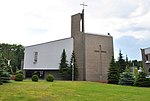Kalwaria Panewnicka

Kalwaria Panewnicka is a complex of chapels located near the Franciscan monastery in Katowice, along with the adjacent park area. The 8-hectare site, owned by the Franciscans of the Province of the Assumption of the Blessed Virgin Mary in Katowice, is enclosed by a brick wall. Within Kalwaria Panewnicka, alongside the Stations of the Cross, there are rosary chapels and the oldest place of worship on the site – the replica of the Massabielle Grotto, built in 1905. Masses are held there during the summer, as well as May devotions to the Blessed Virgin Mary. Asphalt paths connect the various chapels, and the Kłodnica river flows through the site, crossed by four bridges. Kalwaria Panewnicka is also home to a century-old forest stand. Visitors can access the site by passing next to the monastery on Panewnicka Street or through gates from Związkowa and Franciszkańska streets. Kalwaria Panewnicka is a site for outdoor Stations of the Cross services, especially during Lent. It is also the venue for Passion Plays ("Śląska Kalwaria") and the Ecological Song Festival, Ekosong.
Excerpt from the Wikipedia article Kalwaria Panewnicka (License: CC BY-SA 3.0, Authors, Images).Kalwaria Panewnicka
Książęca, Katowice Ligota-Panewniki
Geographical coordinates (GPS) Address Nearby Places Show on map
Geographical coordinates (GPS)
| Latitude | Longitude |
|---|---|
| N 50.229166666667 ° | E 18.965833333333 ° |
Address
Kościół Akademicki
Książęca
40-754 Katowice, Ligota-Panewniki
Silesian Voivodeship, Poland
Open on Google Maps







